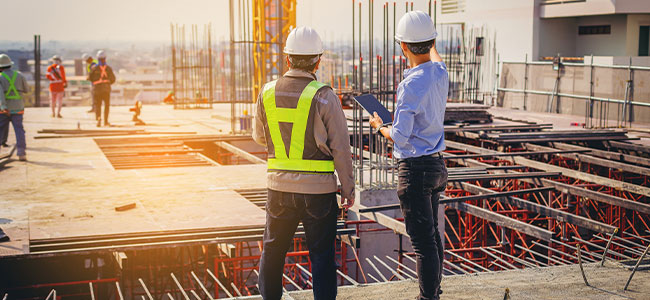
The Most Common Health and Safety Hazards on Construction Job Sites
Seven hazards frequently occur on construction sites. Here’s how recognizing and training workers on these dangers can significantly improve workplace safety and productivity.
- By David Brinkerhoff, Sylvia Fontes
- May 01, 2024
Physical hazards in construction sites are commonplace. They are just one of the many types of hazards construction workers can face, though.
Below are seven common hazards on construction sites and examples of each. Use this guide to compare against your own construction site safety plan. We hope you don’t … but you may find some gaps in your plan that should be filled.
1. Physical hazards are environmental factors that can affect the health of your workers. Examples are falling or flying objects, temperature extremes, radiation exposure, and exposure to excessive noise or vibration levels.
a. Hard hats and safety helmets protect your head from falling objects and side impacts.
b. If the sound coming from a construction site can draw noise complaints from neighbors, imagine how it affects workers on the site. Over time, exposure to elevated noise levels can lead to hearing damage.
c. Studies investigating heat-related mortality outcomes among workers, found that the construction industry had consistently higher fatality rates related to heat stress as compared to other industries.
2. Chemical hazards are harmful substances, such as asbestos, lead, and other hazardous materials. Chemicals can pose serious health risks to workers, including respiratory issues, skin irritation, eye damage, and chronic illnesses like cancer. Workers must know how to understand material safety data sheets (MSDS), recognize the symbols associated with hazards, and wear necessary personal protective equipment (PPE) when working with chemical hazards.
Furthermore, chemical spills or improper disposal can have severe environmental consequences and lead to legal issues. Remember, too, that dust can be a chemical hazard. The threat isn’t always evident or easy to detect.
3. Biological hazards include exposure
to bacteria, viruses, and other health-compromising agents. While these are less common on construction sites, the identification of any existing biological hazards and asking workers not to come to the job site when sick can help prevent illness and lost work hours.
One special area of concern is soil contaminated with certain types of fungi. Failure to identify and mitigate mold can be hazardous not only to workers but also to the people who will occupy the site after construction.
4. Ergonomic hazards can lead to musculoskeletal issues. Things like improper tool design or workstation layout fall under this category. It is also important that workers follow safety standards for jobs like lifting heavy objects or any task that involves prolonged or unusual positioning of the worker’s body.
5. Electrical hazard examples include working near power lines, improper use of extension cords, and faulty electrical systems. Proper training and equipment inspection are crucial for mitigation. Employees working with electrical equipment or near electrical power sources should be aware. It only takes one mistake to render severe consequences. Improper electrical installations can also compromise the integrity of the finished building or structure, leading to potential safety issues for future occupants and potential legal liability for the construction company.
6. Psychological hazards on construction sites are often overlooked, but they can be a source of major concern. Stress, harassment, and other psychological factors can affect a worker’s performance and well-being — and that can lead to diminished workforce performance and even litigation. Construction work, by itself, can be severely stressful. Addressing psychological hazards shows a commitment to a company culture of safety that values the overall well-being of workers and their on-the-job satisfaction.
7. Safety hazards on a construction site can be the most straightforward but often the most disregarded. Slips, trips, and falls are common examples of safety hazards. Construction site hazard awareness training can go a long way in preventing such incidents. OSHA says “struck-by” hazards are in the top four on the checklist of major construction hazards. Wearing a safety helmet with a chin strip safely secured can help protect against head injuries.
Construction Workplace Safety Is a Team Effort
Workers not only suffer physically and mentally from construction site accidents, but safety mishaps can negatively affect project timelines and result in financial losses. When workers know you sincerely care about their safety, they tend to be more productive, stay with you longer, and express increased job satisfaction. When you recognize the importance of these seven types of hazards and train your workers to identify them, you’ve taken a significant step towards avoiding accidents and making sure your construction site safety strategy is solid.
This article originally appeared in the April/May 2024 issue of Occupational Health & Safety.